Pyramidal thuja: description, types and cultivation
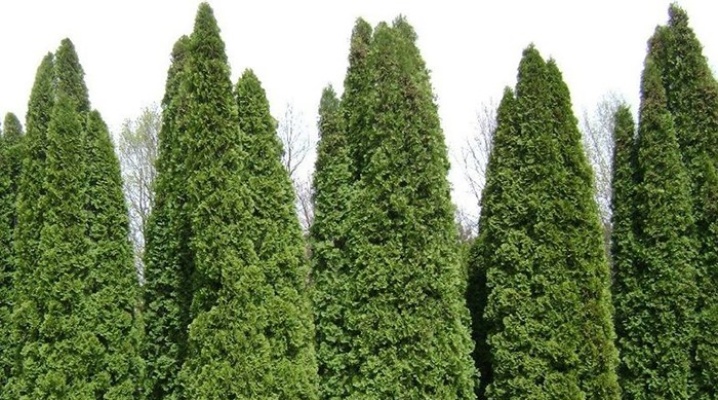
Many people know that walking near conifers is very beneficial. Essential oils, which are secreted by trees belonging to the class of conifers, have an extremely beneficial effect on the state of the bronchopulmonary system. You can grow a beautiful and useful tree at home, because there are quite a few varieties and species. In this article, we will talk about the pyramidal thuja, we will analyze the features of its planting and proper care.
Peculiarities
Thuja pyramidal is a tree "migrant", its homeland is the American continent. It was there that the indigenous people used the species to make boats (canoes). Thuja was brought to Europe relatively recently, only 400 years ago. The main initiator of such a resettlement was the monarch of France, who is fond of botany, Francis I. Thanks to him, several trees were planted in a park near Versailles and took root there.
According to the scientific classification, the pyramidal thuja belongs to the Cypress family and is a species of the western thuja species. The height of this slow-growing tree differs depending on the variety. Wild western thuja can grow up to 38 m, and the height of cultivated varieties is, as a rule, within 12-13 m. The trunk is straight, with a smooth bark in young specimens and exfoliating in mature specimens. On the cut in the center, there is a pronounced reddish color.
The structure of the wood is not too dense, but rather strong and not subject to decay.
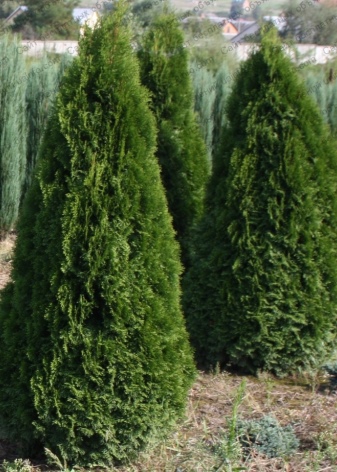
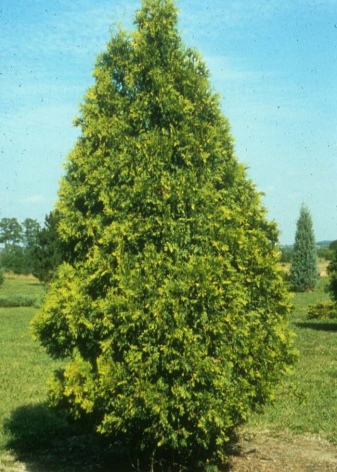
Although the root system is very compact, and sometimes it seems that the tree is not well rooted in the soil, all this is completely wrong. Thuja is quite resistant to strong gusts of wind, is not afraid of moderate frosts, and tolerates drought well. The shape of the crown in cultivated varieties, while the tree is young, visually resembles a pyramid, in mature specimens, the crown acquires slightly different features - it becomes like a column.
The shoots, due to which a beautiful, with a pronounced volume of the crown is formed, occupy almost the entire surface of the trunk from the base to the top. At the same time, the distance from the ground is almost minimal. The shape of the shoots, depending on the variety, can be arched, with the tips raised up, or straight, when the shoots are located on the trunk strictly horizontally relative to the surface of the earth.
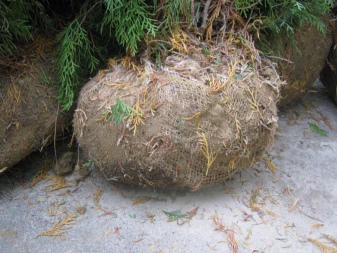
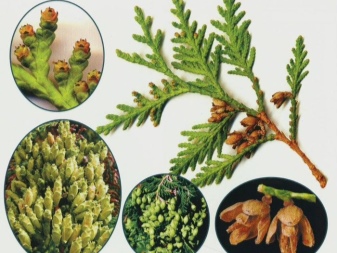
Needles are a modified form of leaves, but in thuja it is somewhat different than in most representatives of this class. In young trees, the needles are soft, acquiring a flatter shape over time and changing the initially smooth surface to a scaly one. The lifespan of needles is small, and does not exceed 3 years, after which they disappear along with small twigs.
The size of the needles is small, they rarely exceed the mark of 0.4 cm. Their main color is green, but the shade can change depending on the season. In summer, light green predominates, and in winter, the color of the needles is most often red-brown or gray-brown. On the shoots during the flowering period, small (from 7 to 12 mm) oval cones are formed, inside which seeds ripen by autumn, in the amount of 2 pcs.
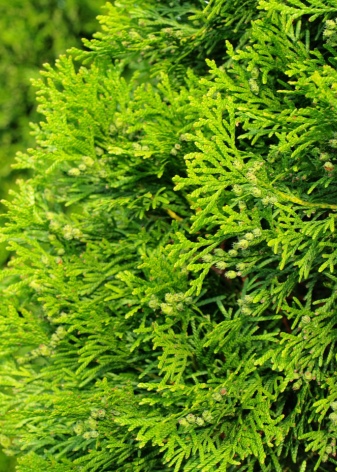
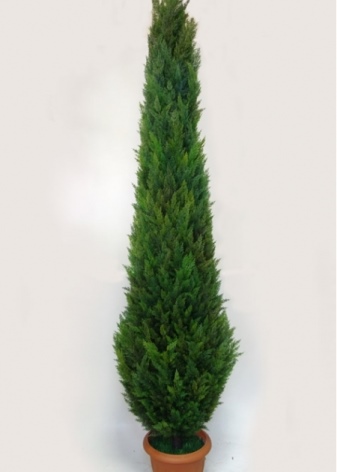
The description of thuja will be incomplete without mentioning the essential oil it secretes, which, in fact, determined its name.The essential oil naturally releases into the environment during hot weather. When wood is burned, the aroma becomes brighter, and therefore it was often used in the ritual of sacrifice. The ceremony also determined the further name - thuo, which translated from Greek means “to sacrifice”.
In modern conditions, oil is extracted from a mixture of leaves, twigs and bark using the steam distillation method. The composition contains camphor, pinene, phenone, sabinene, thujone and other substances characteristic of plants of this class. But thuja pyramidal is used not only for obtaining oil.
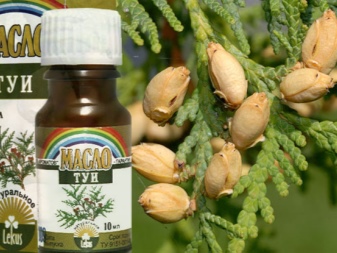
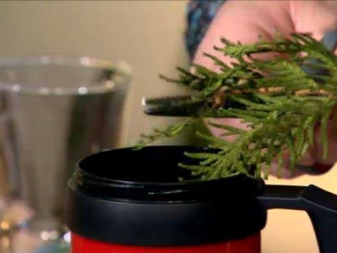
Its beautiful contours and lush, neat crown will look great anywhere, and therefore it is often used in landscaping. And from its wood decks, sleepers and furniture are made.
Varieties
To date, breeders have bred a large number of various varieties of thuja. Each variety has its own characteristics not only in size and color, but also in adaptability to a certain type of soil and the degree of resistance to external factors such as frost, snow, wind and smoke.
- The most popular is perhaps grade "Smaragd"... Slow-growing trees of this variety cannot be ranked among giants, the height of adult specimens does not exceed 5 m. The variety is famous for its resistance to frost and unpretentiousness to the soil composition, although the presence of humus will be an undoubted plus for the good development of the tree.
- Trees of the "Holmstrup" variety rather compact, their height rarely exceeds the mark of 4 m, and the widest part of the dense green crown is no more than 1 m. The trees are frost-resistant, shade-tolerant and not particularly demanding on the soil. But they still grow better on well-moistened fertile loamy soils.
- Variety "Rosentali" known and cultivated most often. The trees are compact, their height, as a rule, is kept within 4-5 m. The columnar shape of the crown is formed due to short, dense, straight shoots. Representatives of this variety are distinguished by slow growth and winter hardiness.
- Low trees varieties "Graceful" it is no coincidence that they received such a name. Their dense crown has a beautiful canonical shape, obtained thanks to the densely "sitting" shoots and brightly colored shiny needles. Distinctive features are winter hardiness and abundant fruiting.
- Frost-resistant variety "Pyramidalis compacta" refers to dwarf species, although under favorable conditions it can reach the 10-meter mark. The older the tree becomes, the more branches appear on the shoots, and the thicker the crown. The needles of young trees have a bluish tint, and in more mature specimens they acquire a rich green color. Trees of this variety do not tolerate direct sunlight, therefore, in order to avoid burns, they are covered in the spring or planted in the shade of other trees.
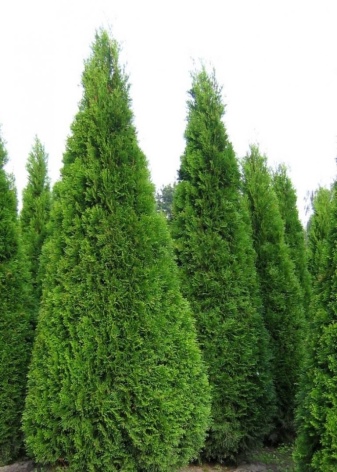

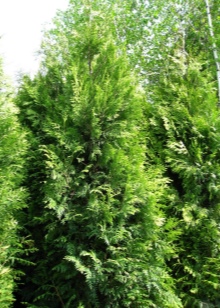
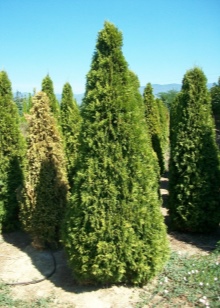
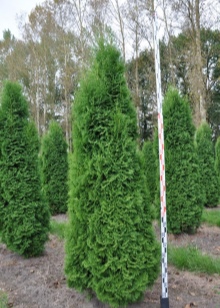
The group of varieties, differing in specimens, whose height is within 10-15 m, is more numerous and diverse.
- Douglas trees have a narrow columnar crown shape, formed from thin, short and straight shoots, on which compact branches with marsh-colored needles are located. The variety is winter-hardy and shade-tolerant. Suitable for all types of planting.
- Variety "Columna" very popular because of its unpretentiousness and beautiful conical crown shape in trees. The scale-like needles that form the crown have a bright green tint that remains unchanged even in winter. Both alkaline and acidic fertile substrates are suitable for planting.
- Frost-resistant, shade-tolerant and undemanding to the composition of the soil grade "Brabant" belongs to the tallest species, trees can grow up to 21 m. For adult specimens, the conical type of crown is characteristic, formed from scaly needles, which retain their bright green tint even in the cold season.
- Winter-hardy variety "Malonyana" It is distinguished by a peaked columnar crown formed from short, densely branching shoots with shiny green needles. Used for almost all types of landings.
- Variety "Spiralis" differs in its twisted in a spiral shoots and short twigs with needles that have a bluish tint. The variety is winter-hardy and fast-growing.
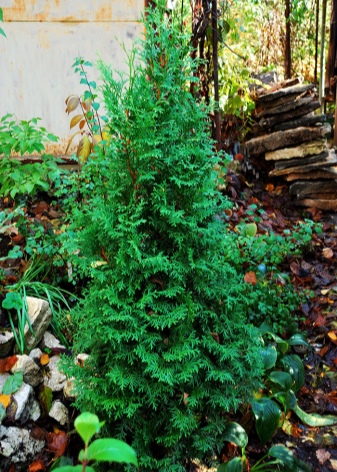



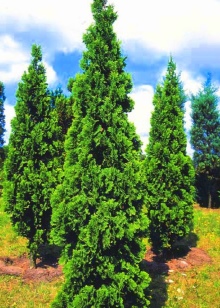
How to plant?
It is not difficult to plant a pyramidal thuja sapling in the ground - the main thing is to choose the right place for the variety and prepare the tree itself. It is best to plant in the spring, after a positive temperature has been established, or in the fall, while the temperature is in the positive range. During this period, the seedling has time to take root.
Preparatory measures are reduced to the choice of a place, preparation of the soil and the tree itself. When choosing a place, it is necessary to take into account not only the variety of the seedling, but also the presence of other ornamental trees nearby, in particular, the distance between them. For thuja, the optimal distance is considered to be 1-5 m.
Although most varieties belong to unpretentious species, for good rooting of the seedling, additional feeding is still required, which is laid on the bottom of the pit. As a top dressing, manure, compost or a mixture of ash and soil are suitable (for 1 m² of soil - 3 kg of ash).
The soil that is covered from above must be mixed with peat and sand.
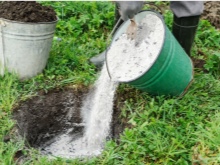
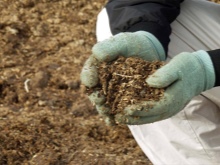
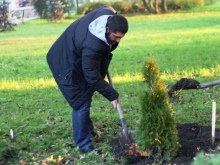
The diameter of the hole and its depth should be slightly larger than the soil ball in which the seedling is located. For a width of 40 cm is enough, and for deepening a hole - 30. Before planting a tree, it must be placed in a container with water for some time and kept until the end of the release of air bubbles.
After the preparatory activities, you can start planting. Place the tree in the center of the hole, and, slightly holding it by the upper part, fill it with the prepared substrate so that the root collar of the trunk is visible, and then water it. At the end, the near-stem space is sprinkled using peat, sawdust and other suitable material for this. This must be done carefully, trying not to close the trunk itself and the lower shoots.
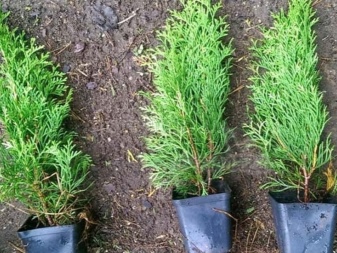
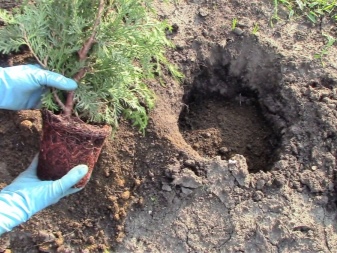
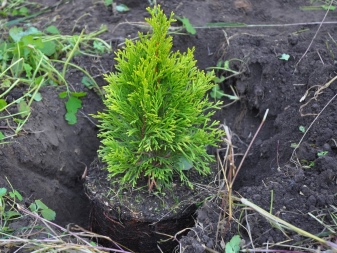
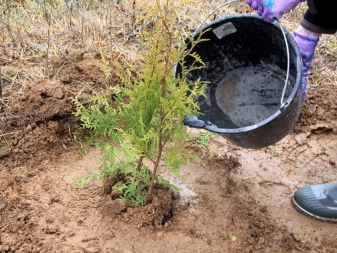
Correct care
In order for a seedling to turn into a luxurious thuja, it is necessary to properly care for it. Components of care: watering, feeding, preparing for winter and forming the crown.
Water for thuja is very important, its lack will affect the appearance, and an excess can lead to decay and subsequent death of thuja, therefore watering should not be too abundant, but regular. For small seedlings, 8-10 liters of water per week is enough, and for larger specimens, this rate needs to be increased 5 times.
In hot and dry weather, it is watered two or even three times a week. The best time of day for this procedure is early morning or late evening. In the summer, seedlings can not only be sprayed, but also need to be sprayed. Thanks to this procedure, the needles are freed from dust and other contaminants, and also begin to smell fragrant.
Top dressing has a very good effect on a young tree: it grows faster, and the color of the needles acquires a more saturated shade. You need to feed the tree annually; for good development, 1 time is enough. The best feeding periods are spring or summer. When fertilizing during planting, the next top dressing should be carried out no earlier than 2 years later.
The formation of the crown occurs by pruning the shoots with a sharp secateurs. The procedure should not be carried out 2-3 years after planting, since thuja needs some time for good rooting and growth. Pruning is done in the spring, until the buds have blossomed, while not only trimming annual shoots, but also completely removing dry and affected branches.
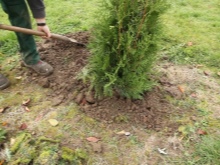
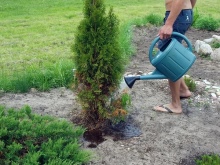
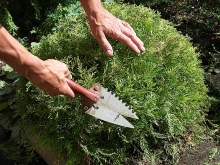
Regardless of the variety, young thuja trees up to 5 years old require shelter. And for the preservation of the root system, the tree is covered with mulch after hilling, the shoots can be covered with spruce branches.
Reproduction methods
Thuja can be propagated in only two ways: by seed and cuttings. The seed method is not very popular, since there is a high degree of probability of loss of varietal characteristics, and it takes a very long time to nurture a slow-growing thuja from the seed.
The best propagation option is cuttings. For this method, 20-centimeter, 3-year-old shoots from the top of the tree are suitable. Before planting, they are disinfected and treated with a stimulating solution.
Rooting will require a suitable container with holes in the bottom, soil and drainage. First, they put the drainage, then the prepared substrate, and only after that the cutting is inserted, and then watered. The pot is placed in a darkened room for 2 months, where the temperature should not be lower than +20 ° C. After the expiration of the period, the rooted cuttings can be planted in a greenhouse, and after 2 years - in open ground.
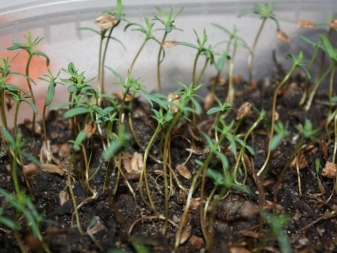
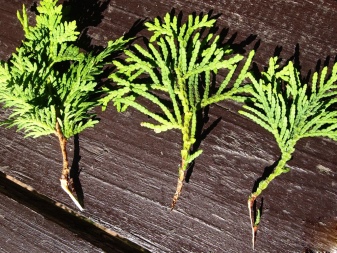
The soil that is covered from above must be mixed with peat and sand.
Diseases and pests
Thuja pyramidal, like all plants, is susceptible to disease. Most often, trees suffer from fungal infections and insects.
- The appearance of too many dry shoots and yellowing of the needles indicate the development of a fungus such as tinder fungus.
- With insufficient nutrients and excessive moisture, the root system is often affected. Fusarium is also characterized by yellowing of the needles and drying of the twigs.
- Among insects, the spider mite is most often found. Thin white threads produced by the tick's gland can entangle almost the entire crown, the needles turn yellow and fall off. The disease occurs with insufficient watering.
- The bark and root system can be attacked by the weevil. The reason for the occurrence is too acidic and waterlogged substrate.
- The formation of yellow, rapidly increasing in diameter ulcers on the bark occurs due to the settlement of the thuja false scutellum. And the passages in the bark appear due to the rapid reproduction of the thuja bark beetle.
- Thuja aphid is no less dangerous pest. It affects the needles, as their juice is a treat for the pest.
In case of disease, the tree is treated with insecticidal preparations
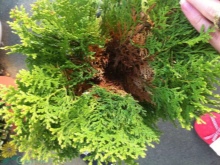
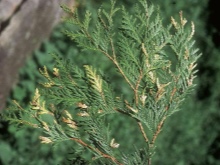
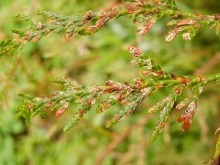
... On the packaging, manufacturers indicate which pests this product helps from, and the method of application, and the single dose required for treatment.
For information on what types of pyramidal thuja are, see the next video.



































































The comment was sent successfully.